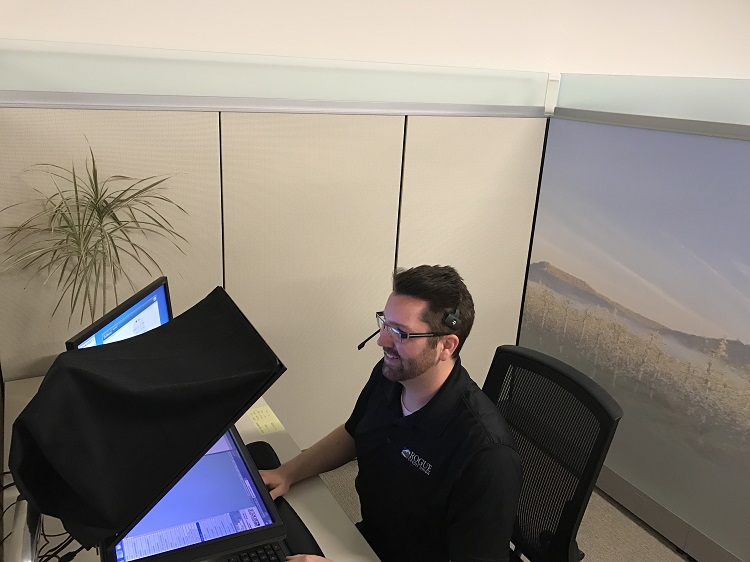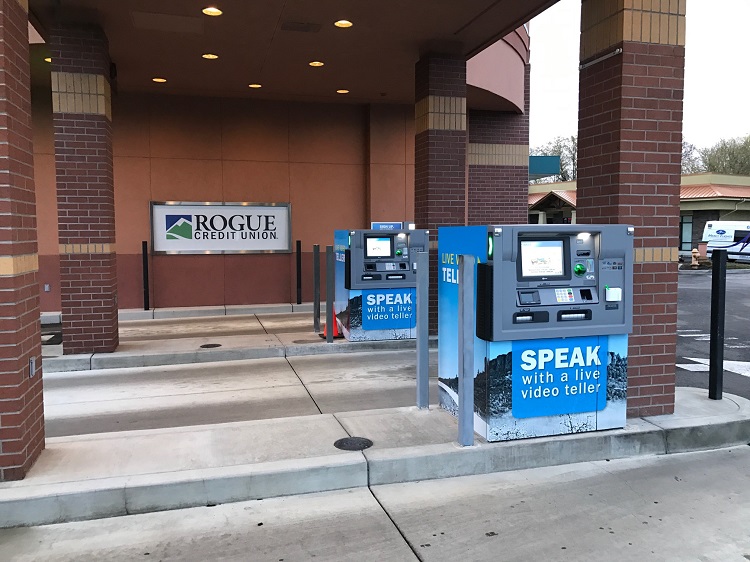Interactive teller machines can be expensive more than six-figures expensive and can inspire fear and confusion among members and employees who aren’t familiar with the technology. Yet, this new teller technology also offers efficiency gains one video teller can serve multiple members simultaneously and the convenience of extended hours.
As more credit unions adopt ITMs also referred to as personal teller machines, PTMs and mold them to meet institutional needs, best practices from across the industry continue to emerge. Here are nine gleaned from three credit unions.
Learning At The Next Level
Like what you’re reading? Callahan’s Media Suite subscription provides even deeper insight to help your credit union thrive with enhanced access to CreditUnions.com and industry publications.
Learn More
No. 1: Maybe Don’t Call Them ITMs
CU QUICK FACTS
Rogue Credit Union
Data as of 12.31.16
HQ: Medford, OR
ASSETS: $1.3B
MEMBERS: 110,092
BRANCHES:17
12-MO SHARE GROWTH: 20.1%
12-MO LOAN GROWTH: 15.7%
ROA: 1.62%
Rogue Credit Union ($1.3B, Medford, OR) operates 13 ITMs, which it calls express teller machines, or ETMs.
The word interactive’ insinuated there wasn’t a live person working with members, says the credit union’s COO, Jeanne Pickens. Calling them express teller machines focused more on the teller experience and what members would expect at a drive-thru. It’s still a personalized experience.
No. 2: Just Say No To Technical Jargon
Rogue operates in 28 counties in Oregon and one in California, some more rural than others, says CEO Gene Pelham. The credit union serves members with varying degrees of technological expectation, so Rogue wants to steer clear from descriptors that imply the ETMS are robotic.
If we said things like technology,’interactive,’or automated,’it would trigger member fear, says Aimee Elko, the credit union’s vice president of remote delivery. We tried to remove those terms to make it more approachable for everyone.
No. 3: Try Before You Buy
In the coming years, Rogue has plans to build a new branch with ETMs near another branch with high foot traffic. But before it does, Rogue wants to give members a taste for using the technology.
In July 2016, Rogue bought an ETM to operate as a traveling unit, Elko says. The unit is currently stationed at Rogue’s Central Point location until the credit union completes its second location in that city. At that point, Rogue will move the unit to its Ashland location as it prepares to build another location there.
The plan is to continue to move it as we build new branches, Elko says.
No. 4: ITMs Are Not The End Of The Teller Line
CU QUICK FACTS
Indiana Members Credit Union
Data as of 03.31.17
HQ:Indianapolis, IN
ASSETS: $1.8B
MEMBERS: 120,400
BRANCHES: 26
12-MO SHARE GROWTH: 9.3%
12-MO LOAN GROWTH: 7.8%
ROA: 0.45%
Indiana Members Credit Union ($1.8B, Indianapolis, IN) has 13 ITMs, nine of which are in drive-thru locations. By 2018, the credit union plans to double its total machine count, primarily by adding more as drive-thrus.
Drive-thrus ITMs provide flexibility in placement no longer must they be tethered to the building via pneumatic tube as well as a better experience than talking to a teller over a microphone, says John Newett, the credit union’s senior vice president of operations.
In that sense, ITMs as drive-thrus are a service upgrade. But as a way to completely replace the teller line? Not so much.
We’re a little more concerned with how members will react if we take away a teller line to put ITMs in, Newett says. I don’t think it would be popular.
No. 5: ITMs Aren’t Quite Plug-And-Play
Retrofitting drive-thrus with ITMs will take Indiana Members several years, Newett says.
It’s an involved process that must accommodate the different structural requirements between drive-thrus and ITMs. At Indiana Members, drive-thrus are built into 18 inches of concrete; ITMs require 30 inches to brace the bigger machines.
It will probably be several years before we upgrade them all, Newett says.
No. 6: Communicate That Tellers Are Real … And Local
For Indiana Members, ITM adoption is higher when the institution shows members how to use the machines. That’s why for the first month after installing a new machine, the credit union has an associate stand next to the ITM, welcome members, and prompt them to use the machine.
We want them to know there is a real, live person working in there in the same building or down the street on the other end of that machine, Newett says.
Rogue does something similar and invites its live tellers to be on-site at the introduction of its ETMs.
There’s a face members will see in the future helping guide them through the machine for the first time, says CEO Pelham.
Additionally, this live element reinforces that employees on the other end of the video feed are local Oregonians and not in some anonymous call center miles away.
We get that frequently, says vice president of remote delivery Elko. They ask, Am I talking to somebody that is out of state?’ We make sure to explain they are in a central, local location.
Click through the tabs below to check out Rogue and Collins ITM set up.
$(‘.collapse’).collapse()
1. Rogue’s ETM Representative

Seated in what the credit union affectionately calls its ‘Shower Stalls,’ Rogue representatives serve members in closed rooms and in front of backgrounds depicting local landscapes.
2. Rogue’s Drive-Thru ETMs

Rogue’s drive-thru ETMs clearly promote the ability to speak with a live video teller.
3. Collins’ Collin Welcomes Members

Collins’ cardboard cutout, Collin, prompts members to give this new technology a try.
4. Collin’s Footprints

Blue footprints lead members through the branch to Collin and the credit union’s newest technology.
Collins Community Credit Union ($1.1B, Cedar Rapids, IA) has a member service consultant stationed at its in-branch ITMs. Only, he’s made from cardboard.
Collins uses NCR as its ITM provider. Find your next solution in the Callahan & Associates online Buyer’s Guide.
Named Collin, the cut-out is an amalgamation of several of the credit union’s actual bearded member service consultants. Collin has a word bubble introducing members to the ITM, and the credit union even puts footprint stickers on the branch floor that leads members from the door to the ITM.
We want to show members this is an alternative for them, says credit union CEO Stefanie Rupert.
No. 7: ITMs Can Open Doors To New Markets
CU QUICK FACTS
Collins Community Credit Union
Data as of 12.31.17
HQ:Cedar Rapids, IA
ASSETS:$1.1B
MEMBERS:71,680
BRANCHES:16
12-MO SHARE GROWTH:26.9%
12-MO LOAN GROWTH:25.2%
ROA:0.39%
Collins introduced ITMs last summer and now operates four. It originally adopted the technology as a low-cost entry into new markets in its 38-county footprint.
Expansion is critical to our strategy simply because the more people we reach, the more we are helping, says Rupert. That said, expansion is expensive.
Collins partnered with Price Chopper, a locally owned chain of grocery stores, and placed three of its four ITMs in Des Moines-area stores. The reaction has been positive and support deep enough for the credit union to open a traditional brick-and-mortar location in February of this year.
No. 8: Dual Entry Might Not Be A Bad Thing
Collins chose NCR as its ITM provider after conducting significant due diligence. The credit union researched two other makers while also consulting a large credit union and sharing best practices.
Double entry is not a barrier. It’s a check and balance to make sure the transaction is accurate.
NCR, however, does not integrate with Collins’ core processor, Fiserv Portico. Therefore, the credit union must manually key in information from one system to the other. Clearly a bug, right? Rupert disagrees. To her, it’s a feature.
Double entry is not a barrier; it’s a benefit, she says. It’s a check and balance to make sure the transaction is accurate. And, in fact, the member doesn’t notice a delay.
No. 9: Get The Buy-In Of Your Employees
In Rupert’s experience, a skilled, knowledgeable staff has better conversations about products and services. That’s why she requires employees to use the ITMs for their own personal banking. The CEO turned off her employees’ ability to check their accounts through the core system and disallowed certain transactions at the teller line.
Disallowed transactions include:
- Check printing
- Statement printing
- Money order printing
- Temporary check printing
- Savings bond redemption
- Third party check deposits
- Document completion
- Cash advances
- Shared branching transactions
I thought this was going to blow up and turn into a revolt, Rupert says. But no. It’s easy. So why wouldn’t you take the easiest route for the simplest transactions?